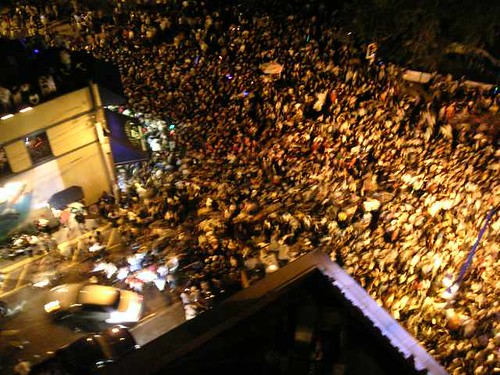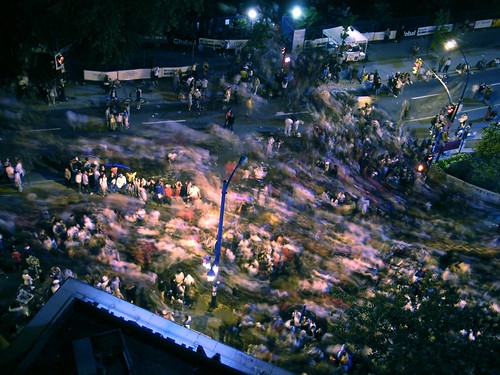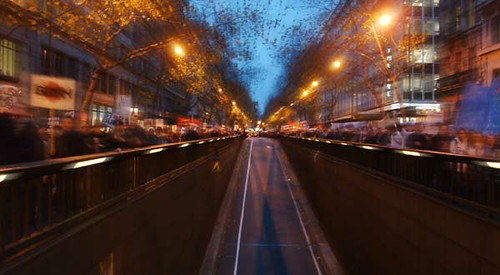Urbanization of Panic

I recently came across an interesting little piece called City of Panic written by Franco Berardi in the journal Voices of Resistance from Occupied London.
Berardi describes the state of urban territory as striated by new dimensions of panic where the mental and physical environment of the city overlap in an over-saturation of signs “that create a sort of continuous excitation," he writes, "a permanent electrocution, which leads the individual mind as well as the collective mind to a state of collapse.”

[Image: Signs in Boston indicate presrcibed evacuation routes for the city. Photo via Bike Nerd.]
In short, he talks about how human beings as social organisms are excessively agitated by the urban experience to the point of existing in a constant state of panic. A cultural agitation exacerbated by technology which has enabled a new economy beyond the production of material goods to one of “semiotic goods,” as he calls them, that functions within a kind of hyper-sprawl of frenzied sociality and contagious information. Berardi writes:
The problem of panic is generally connected with the management of time. But we can also see a spatial side to panic. During the past centuries, the building of the modern urban environment used to be dependent on the rationalist plan of the political city. The economic dictatorship of the last few decades has accelerated the urban expansion. The interaction between cyber-spatial sprawl and urban physical environment has destroyed the rationalist organisation of the space.
In the intersection of information and urban space we see the proliferation of a chaotic sprawl following no rule, no plan, dictated by the sole logic of economic interest. Urban panic is caused by the perception of this sprawl and this proliferation of metropolitan experience. Proliferation of spatial lines of flight.
The metropolis is a surface of complexity in the territorial domain. The social organism is unable to process the overwhelmingly complex experience of metropolitan chaos. The proliferation of lines of communication has created a new kind of chaotic perception.

[Image: Mapping comunications networks and global web traffic, photo via.]
He then portends that the urban terrain is no longer understood as a mere economic pattern but as a psychopathological one as well. While this “digitalization and info-sphere” largely defines the complexion of today’s metropolis, the result he says is a political and economic crisis of bursting attention span, pressurized time management, and neverending cognitive anxiety, all of which translates to a City of Panic.
I imagine it as panic en-globalized. Or, panic as a new prototypical capitalist form, or something. The economic engines of the world spurred on by frenetic geographies of panic development; panic as more than just an urban dimension but as a 21st century planning principle. Is it a transnational institutionalization of panic through global urbanism that makes the world go round today?
Back to Berardi's point, however, if I understand him correctly (and in my own words), human society as a system for social organization is compressing and fragmenting under the pressures of its own urban psychosis, self-constituted in the nature of these "semio-cities" (as I might choose to call them), and that civilization is kind of burying itself in the environmental traces of this collective panic, as if cities were mass psychospatial fossils, if you will, ready to leave the future imprints of our psychic breakdown in the skin of the earth forever.


[Image: "Human Streams" from Waxy Poetic.]
Taking the City of Panic a bit futher in Subtopian terms, panic has become the main ingredient that binds the urban experience, perhaps even determines the geopolitical climate as well, if we think of globalization and the 'War on Terror' purely in terms of the spaces it occupies. We could examine the implicit panic in structures like border fences and detention centers, bunkers and nuclear shelters, urban conflict zones, foreign embassies, paramilitarism and slumaphobia, etc. There are entire Cold War landscapes modeled on a panic preparedness. Berardi likens this ubiquitous panic to an electrical charge, but I also see it is a critical vibration in some way - or, maybe more like a resident frequency that signifies the simultaneous (in)stability of the global city's core social and structural foundations. Panic as a volatile urban harmony. We have engineered a range of metropolises that vibe on the edge of collapse at every level.
I get a little leery of some of the language in his article (but I get even more so of my own in relaying it!), so, in other words, while the article riffs off some classic post-modern theory on media saturation, semiotic bombardment, information barrage, globalization, and ultimately a culture of fear that has already been written about extensively, it also provokes good reflection on the ways fear is transmitted in the very genetic make-up of our cities, in the spatial logic that organizes and rearranges the social infrastructure of global capital.

[Image: Unfortunately, I Googled Imaged this one and can't recall the site. I will try to cite this one soon.]
Berardi’s article not only shares the title of Paul Virilio's recent book but leans towards similar observations, namely how the contemporary city is defined by a kind of de facto psychopathology that is embodied in the very spaces and architectural rationales that order urbanization today, from gated communities to urban surveillance landscapes, to the last dying refuges of public space that have been overwhelmed by privatization and a complete hyper securitization of the built environment at all scales. It is not entirely unobvious that panic appears almost as if it were a chief modus operandi for much of the world’s planning strategy. We've moved past the kind of bombastic but functional fear that the nuclear threat brought towards a more dysfucntional domestic terror that keeps everything on edge where at any moment something on a smaller local scale could suddenly cause considerable mayhem. Either way the current urban response is less on how to prevent crisis and more so on how to armor ourselves from its penetration.
Perhaps more so than ever cities today are defined by a collective psychology whose roots flourish in the very physical forms that constitute the metropolis. This is a topic I am very interested in myself, particularly in the ways the production of cityscapes are used as a means for devising a 'culture of fear,' or what could be also referred to as a hysteria of fortress urbanism. I am extremely curious about the psychological effects of armoring our skyscrapers, fortifying our public spaces, walling ourselves off from every possible threat. And I wonder, how are these threats themselves reproduced or perceived in the very process of trying to secure ourselves from them? How must we consider such trends in urban design from a psychological vantage? What do our obsessions with securing our environment mean in the cross-pollination of global culture? It is the direct correlation between landscapes, anxiety and cognition that is of interest to me in the context of a City of Panic.

[Image: From a film called Half Life by Matt Hulse, 2004.]
Part of the goal of Subtopia is to try to look at the pervasive discourse around a security culture through a psycho-spatial lens, to better understand, f.e., how gated communities, security fences, and ubiquitous surveillance are expressions of a deeper cultural pathos. And so, I wonder how the militarization of urban space not only acts as a planning tool for controlling cities (or, perhaps, designing them for the sole purpose of military occupation), but also as a psychological apparatus for expanding the ideals of militarism, i.e., to militarize our egos, our religions, our cultural identities, and so forth. The city as the ideal military recruiter.
One might ask, based on the panic-stricken nature of our culture, what is the current diagnosis and mental health state of western democracy? Or, how can the city be viewed as an architectural weapon to enforce behavior, to mandate neo-liberalism in a way, to turn a population into an obedient supporter of rampant commerce? What are the inherent narratives of power that run through spatial constructs like maximum-security prisons, shopping malls, refugee camps, suburban sprawl, and the hardened borderzones between nation-states? Is there a psychopathological connection between them? Is there a new urban archetype here to be deconstructed? I suppose to some degree I am trying to document these realms of environmental design and, hopefully in the future be able to offer in more constructive terms the behavioral implications of such place-making. In the end, I hope Subtopia can help qualify some of the consequences of this psychological underwriting of a what we might call a globalized architecture of control.







2 Comments:
I was searching for something related to urban semiotics. Chanced upon your blog. I like your thoughts and it deepens my interest in urban semiotics further. Thanks.
Thanks for featuring my still image, but in fact it's from an earlier film called 'There Is Only Light' that was shot in Warsaw, Poland. I set myself the task of filming the city at night over the course of a week. Working with Super 8mm, this meant long exposure times, and thus blurring, over-exposure. I was helped a little by the snow, reflected light. But yes, it is a paranoid vision.
Post a Comment
<< Home